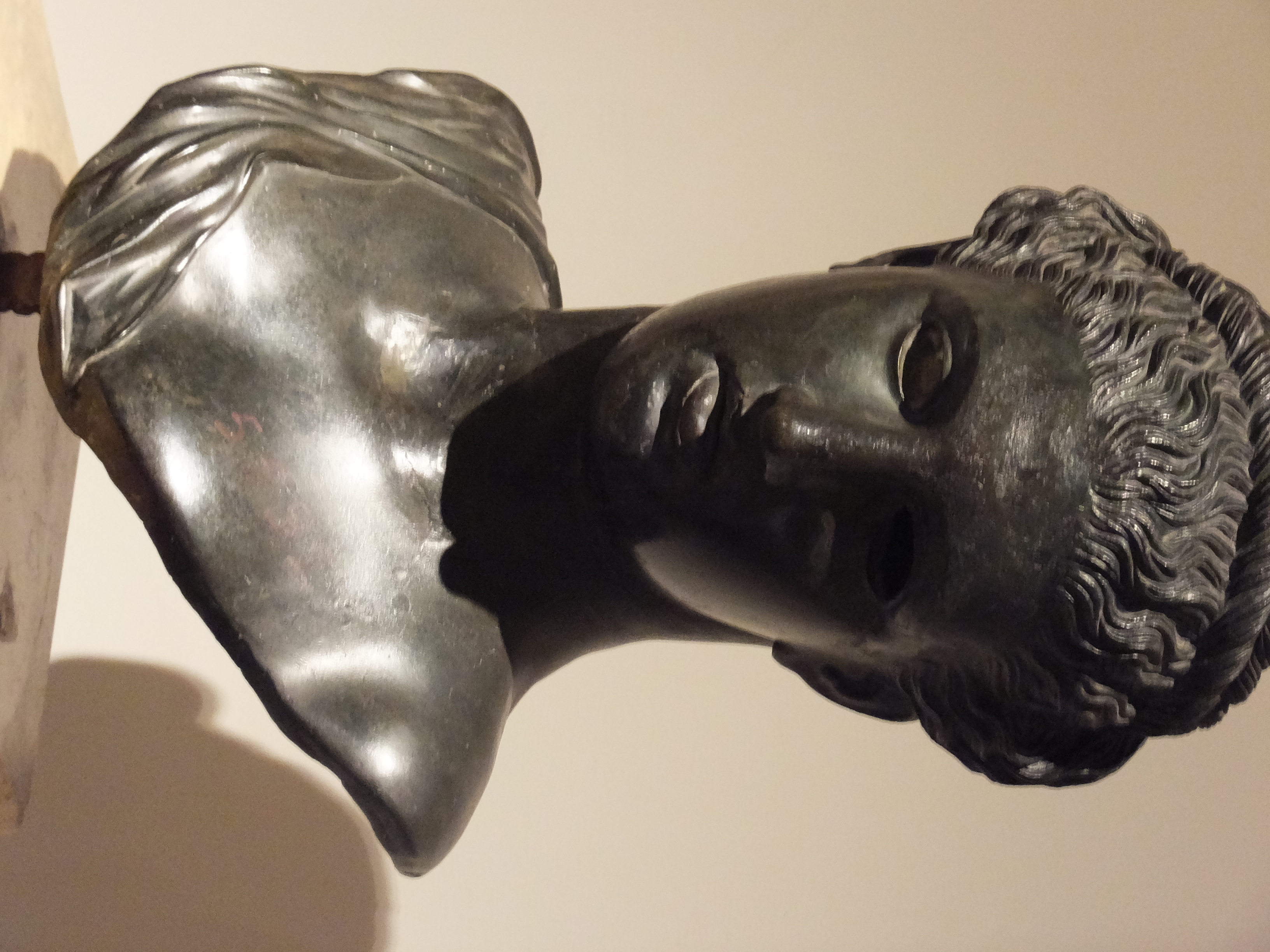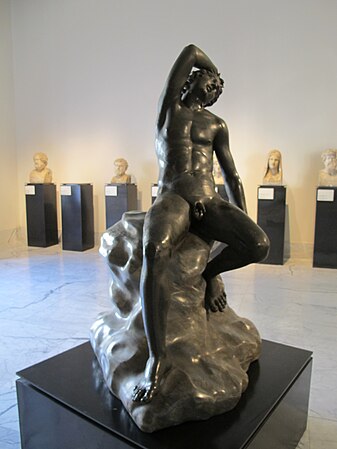Washington, DC—An unprecedented exhibition of some 50 rare bronze sculptures and related works from the Hellenistic period will be on view at the National Gallery of Art from December 13, 2015, through March 20, 2016. Previously at the Palazzo Strozzi, Florence, and the J. Paul Getty Museum, Los Angeles, Power and Pathos: Bronze Sculpture of the Hellenistic World showcases bronze sculptures that are remarkably lifelike, often enhanced by copper eyelashes and lips and colored glass or stone eyes. Of the many thousands of bronze statues created in the Hellenistic period, only a small fraction is preserved. This exhibition is the first to gather together so many of the finest surviving bronzes from museums in Europe, North Africa, and the United States.
“We are delighted to present visitors with this rare opportunity to see these dazzling works up close,” said Earl A. Powell III, director, National Gallery of Art, Washington. “We are grateful to the lenders—museums in Austria, Denmark, France, Georgia, Great Britain, Greece, Italy, Spain, Tunisia, the United States, and the Vatican—as well as Bank of America for their generous support.”
During the Hellenistic period—generally from the late fourth century BC to the first century AD—the art and culture of Greece spread throughout the Mediterranean and lands once conquered by Alexander the Great. Through the medium of bronze, artists were able to capture the dynamic realism, expression, and detail that characterize the new artistic goals of the era.
“The works from the Power and Pathos exhibition represent a turning point in artistic innovation during one of the most culturally vibrant periods in world history,” said Rena De Sisto, global arts and culture executive, Bank of America. “We’re thrilled to be the National Tour Sponsor and to help bring this important collection to D.C. in hopes to inspire curiosity and wonder.”
Exhibition Organization and Support
The exhibition was organized by the National Gallery of Art, Washington; the J. Paul Getty Museum, Los Angeles; and the Fondazione Palazzo Strozzi, Florence, in collaboration with the Soprintendenza per i Beni Archeologici della Toscana.
Bank of America is the national sponsor of this touring exhibition.
The exhibition is also made possible through a generous gift from an anonymous donor. The Marshall B. Coyne Foundation has provided additional support through the Fund for the International Exchange of Art. This exhibition is supported by an indemnity from the Federal Council on the Arts and the Humanities.
Exhibition Highlights
Power and Pathos brings together the most significant examples of Hellenistic bronze sculpture to highlight their varying styles, techniques, contexts, functions, and histories. The conquests of Alexander the Great (ruled 336–323 BC) created one of the largest empires in history and ushered in the Hellenistic period, which ended with the rise of the Roman Empire. For some 300 years after Alexander’s death, the medium of bronze drove artistic experimentation and innovation. Bronze—surpassing marble with its tensile strength, reflective surface, and ability to hold the finest detail—was used for dynamic poses, dazzling displays of the nude body, and vivid expressions of age and character.
“Realistic portraiture as we know it today, with an emphasis on individuality and expression, originated in the Hellenistic period,” said exhibition curator Kenneth Lapatin. Jens M. Daehner, co-curator, added, “Along with images of gods, heroes, and athletes, sculptors introduced new subjects and portrayed people at all stages of life, from infancy to old age.” Both Daehner and Lapatin are associate curators in the department of antiquities at the J. Paul Getty Museum.
A widespread ancient phenomenon, Hellenistic art is found not only throughout the Mediterranean, but also in regions far away, such as Thrace in the Balkans, ancient Colchis (in the Republic of Georgia), and the southern Arabian Peninsula. Through several thematic sections, the exhibition emphasizes the unique role of bronze both as a medium of prestige and artistic innovation and as a material exceptionally suited for reproduction. The exhibition is divided into sections as follows:
Introduction: The Rarity of Bronzes: Large-scale bronze statues have rarely survived from antiquity, as most were melted down so that their valuable metal could be reused. Rows of empty stone pedestals can still be seen at ancient sites. Lysippos of Sikyon (c. 390–305 BC), the favorite sculptor of Alexander the Great, created 1,500 works in bronze, according to Pliny the Elder. None survive; their existence is known partly from later copies and statue bases inscribed with the artist’s name, such as the one on view at the beginning of the exhibition. Many bronzes known today have been preserved only because they were accidentally buried or lost at sea, then recovered centuries later by archaeologists, divers, and fishermen.
Alexander and His Successors: Lysippos is credited with creating the image of Alexander the Great that artists have perpetuated through the centuries: a man of vigor, fit and lithe, clean-shaven, with long, windswept hair. The statuette Alexander the Great on Horseback, in bronze with silver and copper inlays, may be a small-scale version of a lost monumental sculpture that Lysippos created to commemorate Alexander’s victory over the Persians in 334 BC. Portraits of Alexander provided the models that his successors would emulate, resulting in the distinctive genre of ruler portraiture that emerged in the Hellenistic period.
Rulers and Citizens/Likeness and Expression: Realistic features and depictions of emotional states are hallmarks of Hellenistic sculpture. Individualized portraits superseded the largely idealized types of earlier periods. Hellenistic portraits emphasize pathos—lived experience—appealing to viewers’ emotions by conveying an individual’s state of mind or experience of life through facial expression or gestures. Citizens and benefactors honored with statues were shown clothed, while rulers were portrayed nude or in armor, sometimes on horseback. Nudity, traditionally reserved for images of athletes, heroes, and gods, became an artistic attribute of Hellenistic rulers or military leaders.
Bodies Real and Ideal: Hellenistic sculptors continued to create idealized figures, but with a new interest in realistic detail and movement, as seen in the Boy Runner, a statue of a boy athlete shown only at the National Gallery of Art. Many artists took inspiration from Lysippos, often considered the most important artist of the Hellenistic period. He specialized in athletic figures in their prime, emphasizing their muscles and rendering their hair disheveled from sweat and exercise. Lysippos also introduced new, elongated proportions and smaller heads, making his figures appear taller and more graceful than those of the Classical period.
Apoxyomenos and the Art of Replication: The process of casting bronze statues in reusable molds encouraged the production of multiple copies of the same statue. The image of an athlete known as an Apoxyomenos (“scraper”) appears in two bronze versions: a full-length statue excavated at Ephesos in present-day Turkey (on loan from the Kunsthistorisches Museum in Vienna, Austria) and a bronze head known since the 16th century (now in Fort Worth, Texas), which once formed part of a comparable statue. Athletes competed nude, their bodies coated in oil; after exercising, they scraped themselves clean with a strigil, a curved implement that removed the oil and accumulated dust and grime.
Images of the Divine: The expressive capabilities of bronze and the dynamic styles of Hellenistic sculpture were adapted to representations of divine beings. Their images became less ideal and more realistic or “human.” The statuette Weary Herakles, for example, shows the hero fatigued rather than triumphant after completing the labors that earned him immortality. The love-god Eros, formerly shown as an elegant adolescent, is transformed into a pudgy baby, inspiring Roman images of the god Cupid and putti of the Italian Renaissance. In the Hellenistic era, deities became more accessible, now thought of as living beings with changing physical and emotional states.
Styles of the Past/Roman Collectors and Greek Art: A high regard for history characterizes the Hellenistic period. Artists created statues and statuettes in styles from both the recent and distant past. Statues of Apollo on view echo the stiff frontal figures of youths known as kouroi that were dedicated in Greek sanctuaries and cemeteries throughout the sixth century BC. In contrast, a bust of the Doryphoros (Spear Bearer) copies a work by Polykleitos, one of the most famous classical sculptors of the fifth century BC. Most of the sculptures in this section adorned the villas and gardens of prominent Romans who eagerly collected Greek works of art, including the famouse statuette known as the Dancing Faun (Pan), found in the atrium of the House of the Faun in Pompeii, another work shown only in Washington.
From the Hellenistic to the Augustan Era: The Augustan era saw a renewed interest in the idealized styles of Classical Greece. Augustus, the first Roman emperor (ruled 27 BC–AD 14), favored the Classical style for much of his official art to associate his reign with the golden age of fifth-century Athens under Pericles. The sculpture of a boy wearing a himation, a large rectangle of cloth wrapped around the waist, and the nude statue of a youth known as the Idolino (“little idol”), exemplify this trend.
Film and Audio Tour
A film produced by the Gallery in conjunction with the exhibition and made possible by the HRH Foundation provides an overview of art of the Hellenistic period. Narrated by actor Liev Schreiber, the film includes new footage of the ancient sites of Delphi, Corinth, and Olympia, which once were crowded with bronze statues.
For the first time, the Gallery is offering a free audio tour that visitors can download to their mobile devices. Narrated by Earl A. Powell III, the tour includes commentary from exhibition curators Jens M. Daehner and Kenneth Lapatin, and bronze specialist Carol C. Mattusch of George Mason University.
Curators and Catalog
The exhibition curators are Jens M. Daehner and Kenneth Lapatin, both associate curators in the department of antiquities at the J. Paul Getty Museum. Susan M. Arensberg, head of the department of exhibition programs, is the coordinating curator for the National Gallery of Art.
Published by the J. Paul Getty Museum, the fully illustrated scholarly catalog is the first comprehensive volume on Hellenistic bronze statuary. It includes groundbreaking archaeological, art-historical, and scientific essays offering new approaches to understanding ancient production of these remarkable works of art. The 368-page hardcover catalog is currently available. To order, please visit http://shop.nga.gov/; call (800) 697-9350 or (202) 842-6002; fax (202) 789-3047; or e-mail mailorder@nga.gov.

























































